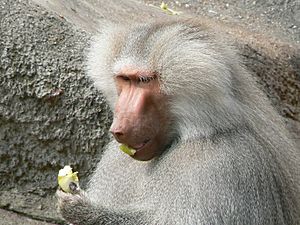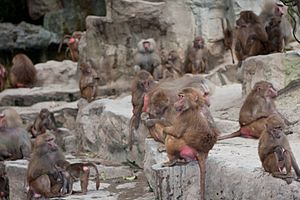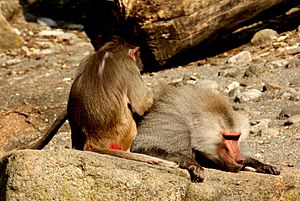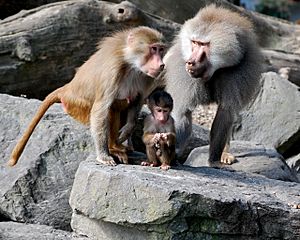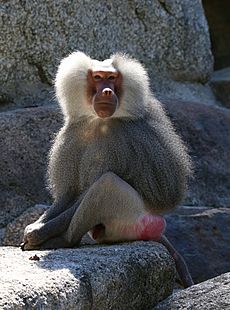Hamadryas baboon facts for kids
Quick facts for kids Hamadryas baboon |
|
|---|---|
 |
|
| Female (left) and male (right) | |
| Conservation status | |
| Scientific classification | |
| Genus: |
Papio
|
| Species: |
hamadryas
|
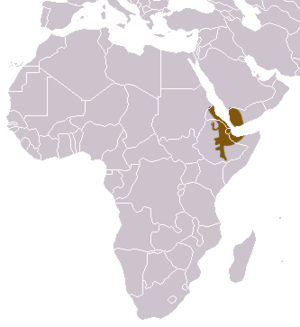 |
|
| Synonyms | |
|
Simia hamadryas Linnaeus, 1758 |
|
The hamadryas baboon (Papio hamadryas) is a type of baboon found in the Old World monkey family. It lives in the northernmost areas of all baboons, mainly in the Horn of Africa and the southwestern part of the Arabian Peninsula. These places offer them safety from many natural predators. The hamadryas baboon was a special animal to the ancient Egyptians. It appeared in their religion, which is why it is also called the 'sacred baboon'.
Contents
About the Hamadryas Baboon
Hamadryas baboons show clear differences between males and females. This is called sexual dimorphism. Males are almost twice as big as females. Adult males have a thick, silver-white mane and cape around their shoulders. They grow this around age ten. Females do not have this cape and are brown all over. Their faces can be reddish, tan, or dark brown.
Male baboons can be up to 80 cm (31 inches) long. They weigh between 20 and 30 kg (44-66 pounds). Females are smaller, weighing 10 to 15 kg (22-33 pounds). Their bodies are about 40 to 45 cm (16-18 inches) long. Their tail adds another 40 to 60 cm (16-24 inches) to their length. It ends in a small tuft of hair. Baby baboons are born very dark brown or black. Their fur gets lighter after about one year. Females can have babies when they are about 4 years old. Males are ready to mate between 5 and 7 years old.
Where Hamadryas Baboons Live and What They Eat
The hamadryas baboon lives in Eritrea, Ethiopia, Djibouti, and Somalia. They also live in the Sarawat Mountains of southwestern Arabia. This includes parts of Yemen and Saudi Arabia. They used to live in Egypt but are no longer found there. These baboons prefer dry areas, savannas, and rocky places. They need cliffs to sleep on and places to find water.
Like all baboons, the hamadryas baboon eats both plants and animals. This means they are omnivorous. They are good at living in their dry homes. In the wet seasons, they eat flowers, seeds, grasses, roots, and leaves from acacia trees. In the dry season, they eat leaves from Dobera glabra and sisal plants. They also hunt and eat insects, spiders, worms, scorpions, reptiles, birds, and small mammals like antelope.
Their drinking habits change with the seasons. During wet seasons, they can find water easily. In dry seasons, they visit a few permanent waterholes. They rest at these waterholes in the afternoon. They also dig their own small drinking holes near natural ones.
How Hamadryas Baboons Live Together
Hamadryas baboons have a unique four-level social system. Most of their social life happens in small groups called one-male units. These are also known as harems. Each harem has one male and up to 10 females. The male leads and protects his females. A harem often includes a younger male who follows the leader. This follower male might be related to the leader.
Two or more harems often join together to form a clan. Males within a clan are usually related to each other. They have a ranking system based on age. The next level is called a band. Two to four clans form a band, which can have up to 400 baboons. These bands usually travel and sleep together. Males rarely leave their bands. Females are sometimes moved or traded between bands by males. Bands might fight over food or land. The adult male leaders of the units are usually the ones who fight. Bands also have single males who are not leaders or followers. They move freely within the band. Several bands might gather at sleeping cliffs to form a troop.
Baboon Group Behavior
The hamadryas baboon society is very different from other baboons. It is strictly male-led. Males control where the females go. They herd them using visual threats. They might grab or bite females who wander too far. Males sometimes try to steal females from other harems. This leads to aggressive fights. Many males succeed in taking a female from another's harem. This is called a "takeover." These fights often involve quick eyelid flashes and yawns to show their teeth.
Like in many animal species, male baboons sometimes use baby baboons as hostages during fights. However, males within the same clan are usually related. They respect their family bonds. Also, female baboons show clear preferences for certain males. Rival males usually respect these choices. If a female does not like her harem male much, she is more likely to be taken by a rival. Young males, often the "follower" males, might start their own harems. They do this by getting young females to follow them. A male might also take a young female by force. Either way, the male will mate with the female when she grows up. Older males often lose their females to followers. They then lose weight and their hair turns brown, like a female's.
In most other baboon species, males leave their family groups. But hamadryas baboon males stay in their birth clans or bands. They keep connections with their male relatives.
People used to think that female hamadryas baboons moved away from their female relatives. However, newer studies show that female baboons stay close to some of their female family members. Females can spend as much time with other females as they do with the harem males. Some females even interact outside their harems. It is also common for females from the same birth group to end up in the same harem. Females can still connect with and help their extended families. This happens even though the harem males control their interactions.
Females within a harem do not show dominance over each other. This is different from many other baboon species. The harem males stop fights between females. This prevents any ranking systems from forming. Still, there are some social differences among females. Some females are more social. They have a stronger bond with the harem male. These females are called "central females." They stay closer to the harem male. Females who spend most of their time farther from the male are called "peripheral females."
Reproduction and Parenting
Like other baboons, hamadryas baboons can breed at any time of the year. The main male in a one-male unit does most of the mating. However, other males might sometimes sneak in. Females do most of the parenting. They feed and groom their babies. One female in a unit might even groom a baby that is not hers. Like all baboons, hamadryas baboons are very interested in babies. They give them a lot of attention.
Dominant male baboons stop other males from getting too close to their babies. They also protect the young from animals that might hunt them. The dominant male is kind to the young. He will carry and play with them. When males reach their teenage years, they show interest in young babies. They might "kidnap" babies by luring them away from their harems. They invite the babies to ride on their backs. This is often done by "follower" males. This kidnapping can be dangerous for the baby. It can lead to them not getting enough water or food. The harem leader will get the babies back from their kidnappers. This is usually to protect their own offspring.
Hamadryas Baboons in Culture
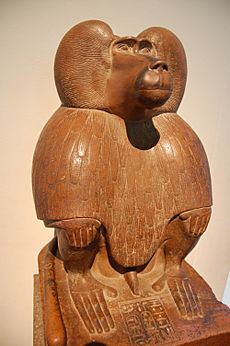
Hamadryas baboons often appear in ancient Egyptian art. They were seen as sacred to Thoth, a powerful god. Thoth had many roles, including being the scribe of the gods. Astennu, a helper of Thoth, is shown as a hamadryas baboon. He recorded the results of the Weighing of the Heart in the afterlife. He was also one of four hamadryas baboons guarding the lake of fire in Duat, the Egyptian underworld.
Before Astennu, there was Babi, or "Bull of the Baboons." He was a fierce god said to eat the insides of the bad dead. Babi was also believed to give good people strength and take them to paradise.
Sometimes, Thoth himself appeared as a hamadryas baboon. He was often shown with the moon on his head. This was another way to show him, besides his usual form with an ibis bird's head. Hapi, one of the Four Sons of Horus, also had a hamadryas baboon head. These sons guarded the organs of the dead. Hapi protected the lungs. So, a stone or clay hamadryas head was often used as the lid for the canopic jar that held the lungs. Hamadryas baboons were respected because some of their actions looked like they were worshiping the sun.
Modern Art
The Grand Babouin sacré "hamadryas" (Great Sacred Hamadryas Baboon) is one of Rembrandt Bugatti's most famous sculptures.
Threats and Conservation
The biggest threat to hamadryas baboons is when their land is turned into farms or pastures. Their only natural predators are the striped hyena, spotted hyena, and a small number of African leopards. These predators live in the same areas as the baboons.
The IUCN Red List said this species was of "least concern" in 2008. This means they are not currently in great danger across their whole range. However, in some local areas, they might be at risk. This is due to large agricultural expansion and irrigation projects. The species lives in the proposed Yangudi Rassa National Park, the Harar Wildlife Sanctuary, and other wildlife reserves in Ethiopia and Eritrea.
See also
In Spanish: Hamadríade para niños



